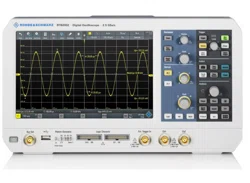Loading ...
Loading ...
Loading ...

Applications
R&S
®
RTB2000
122User Manual 1333.1611.02 ─ 03
"Hamming"
The Hamming window is bell shaped. Its value is not zero at the bor-
ders of the measuring interval. Thus, the noise level inside the spec-
trum is higher than Hanning or Blackman, but smaller than the rectan-
gular window. The width of the spectral lines is thinner than the other
bell-shaped functions.
Use this window to measure amplitudes of a periodical signal pre-
cisely.
"Blackman"
The Blackman window is bell shaped and has the steepest fall in its
wave shape of all other available functions. Its value is zero at both
borders of the measuring interval. In the Blackman window, the
amplitudes can be measured very precisely. However, determining
the frequency is more difficult.
Use this window to measure signals with single frequencies to detect
harmonics and accurate single-tone measurements.
"Flat Top"
The flat top window has low amplitude measurement errors but a
poor frequency resolution.
Use this window for accurate single-tone measurements and for mea-
surement of amplitudes of sinusoidal frequency components.
"Rectangle"
The rectangular window multiplies all points by one. The result is a
high frequency accuracy with thin spectral lines, but also with
increased noise.
Use this function for measurements of separation of two tones with
almost equal amplitudes and a small frequency distance.
Remote command:
SPECtrum:FREQuency:WINDow:TYPE on page 328
Vertical Scale
Defines the scaling unit for the vertical scale.
The displayed values refer to a 50 Ohm terminating resistor. You can use an external
terminating resistor parallel to the high impedance input.
"dBm"
Logarithmic scaling; related to 1 mW
"dBV"
Logarithmic scaling; related to 1 Veff.
"Veff"
Linear scaling; displays the RMS value of the voltage.
Remote command:
SPECtrum:FREQuency:MAGNitude:SCALe on page 329
Waveform
Determines which of the acquired data is displayed. Several types of waveforms can
be displayed in parallel, but at least one waveform must be selected. By default, the
"Spectrum" waveform is selected. From each waveform type, you can also create a
reference waveform for further analysis.
When a new mode is selected, statistical evaluation is restarted.
To clear the results of previous measurements used for statistical evaluation, select
"Reset".
FFT Analysis
Loading ...
Loading ...
Loading ...
